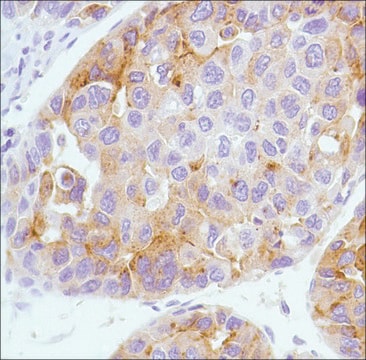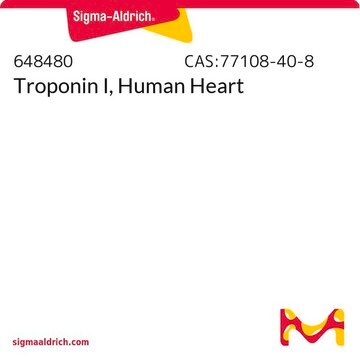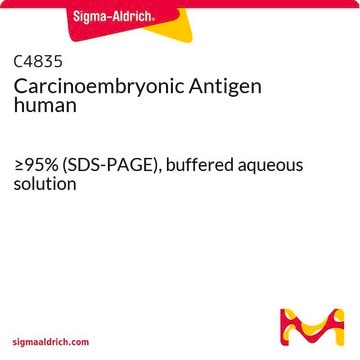RAB0602
Human AFP / Alpha-fetoprotein ELISA Kit
for serum, plasma, cell culture supernatants and urine
Iniciar sesiónpara Ver la Fijación de precios por contrato y de la organización
About This Item
Código UNSPSC:
41116158
NACRES:
NA.32
Productos recomendados
reactividad de especies
human
envase
kit of 96 wells (12 strips x 8 wells)
técnicas
ELISA: suitable
entrada
sample type urine
sample type plasma
sample type serum
sample type cell culture supernatant(s)
assay range
inter-assay cv: <12%
intra-assay cv: <10%
sensitivity: 6 pg/mL
standard curve range: 7.373-1800 pg/mL
método de detección
colorimetric
Condiciones de envío
wet ice
temp. de almacenamiento
−20°C
Información sobre el gen
human ... AFP(174)
Descripción general
The AFP ELISA kit provides for the quantitative measurement of Alpha-fetoprotein in Cell Culture Supernatants, Plasma and Serum.
Aplicación
Please refer to the attached General ELISA KIT Procedure (sandwich, competitive & Indirect ELISA)
Human α-fetoprotein (AFP) ELISA kit has been used to detect levels of AFP in comparison with photoelectrochemical (PEC) immunosensor.
Human α-fetoprotein (AFP) ELISA kit has been used to detect levels of AFP in comparison with photoelectrochemical (PEC) immunosensor.
Acciones bioquímicas o fisiológicas
α-fetoprotein (AFP) facilitates the regulation of fatty acids in both fetal and proliferating adult liver cells. Overexpression of the gene has been observed in acute liver injuries, indicating active liver regeneration. AFP has been associated with fatty liver disease (FLD), a disease that may lead to cirrhosis and hepatocellular carcinoma. It functions as a tumor marker for HCC (hepatocellular carcinoma).
Otras notas
A sample Certificate of Analysis is available for this product.
Please type the word sample in the text box provided for lot number.
Please type the word sample in the text box provided for lot number.
Los componentes del kit también están disponibles por separado
Referencia del producto
Descripción
SDS
Palabra de señalización
Warning
Frases de peligro
Consejos de prudencia
Clasificaciones de peligro
Met. Corr. 1
Código de clase de almacenamiento
8A - Combustible corrosive hazardous materials
Punto de inflamabilidad (°F)
Not applicable
Punto de inflamabilidad (°C)
Not applicable
Elija entre una de las versiones más recientes:
¿Ya tiene este producto?
Encuentre la documentación para los productos que ha comprado recientemente en la Biblioteca de documentos.
Los clientes también vieron
Abdel Hady A Abdel Wahab et al.
Biomarkers : biochemical indicators of exposure, response, and susceptibility to chemicals, 22(7), 621-628 (2016-10-30)
The incidence rate of hepatocellular carcinoma (HCC) is higher in developing countries, and most cases are associated with chronic hepatitis C virus (HCV) infection. To evaluate the circulating proteins as liver biomarkers for the identification of HCC associated with HCV
Garima Singhal et al.
Molecular metabolism, 13, 56-66 (2018-05-14)
Non-alcoholic fatty liver (NAFL) associated with obesity is a major cause of liver diseases which can progress to non-alcoholic steatohepatitis, cirrhosis, and hepatocellular carcinoma (HCC). Fibroblast growth factor 21 (FGF21) plays an important role in liver metabolism and is also
Novel photoelectrochemical immunosensor for disease-related protein assisted by hemin/G-quadruplex-based DNAzyme on gold nanoparticles to enhance cathodic photocurrent on p-CuBi2O4 semiconductor.
Lv S, et al.
Biosensors And Bioelectronics, 96, 317-323 (2017)
Xiaowen Mao et al.
Advanced science (Weinheim, Baden-Wurttemberg, Germany), 7(21), 2002157-2002157 (2020-11-12)
In hepatocellular carcinoma (HCC) patients with extrahepatic metastasis, the lung is the most frequent site of metastasis. However, how the lung microenvironment favors disseminated cells remains unclear. Here, it is found that nidogen 1 (NID1) in metastatic HCC cell-derived extracellular
Hong Liu et al.
Clinical cancer research : an official journal of the American Association for Cancer Research, 23(2), 478-488 (2016-08-19)
The majority of tumor-specific antigens are intracellular and/or secreted and therefore inaccessible by conventional chimeric antigen receptor (CAR) T-cell therapy. Given that all intracellular/secreted proteins are processed into peptides and presented by class I MHC on the surface of tumor
Nuestro equipo de científicos tiene experiencia en todas las áreas de investigación: Ciencias de la vida, Ciencia de los materiales, Síntesis química, Cromatografía, Analítica y muchas otras.
Póngase en contacto con el Servicio técnico











